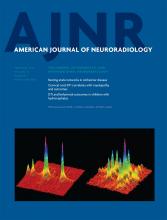Index by author
Kadirvel, R.
- Technical NoteOpen AccessCreation of Bifurcation-Type Elastase-Induced Aneurysms in RabbitsY.H. Ding, R. Kadirvel, D. Dai and D.F. KallmesAmerican Journal of Neuroradiology February 2013, 34 (2) E19-E21; DOI: https://doi.org/10.3174/ajnr.A2666
Kadziolka, K.
- NeurointerventionYou have accessMechanical Thrombectomy in Acute Stroke: Prospective Pilot Trial of the Solitaire FR Device while Under Conscious SedationS. Soize, K. Kadziolka, L. Estrade, I. Serre, S. Bakchine and L. PierotAmerican Journal of Neuroradiology February 2013, 34 (2) 360-365; DOI: https://doi.org/10.3174/ajnr.A3200
Kallmes, D.F.
- Technical NoteOpen AccessCreation of Bifurcation-Type Elastase-Induced Aneurysms in RabbitsY.H. Ding, R. Kadirvel, D. Dai and D.F. KallmesAmerican Journal of Neuroradiology February 2013, 34 (2) E19-E21; DOI: https://doi.org/10.3174/ajnr.A2666
- Review ArticlesOpen AccessReview of 2 Decades of Aneurysm-Recurrence Literature, Part 1: Reducing Recurrence after Endovascular CoilingE. Crobeddu, G. Lanzino, D.F. Kallmes and H.J. CloftAmerican Journal of Neuroradiology February 2013, 34 (2) 266-270; DOI: https://doi.org/10.3174/ajnr.A3032
Kelly, M.
- NeurointerventionYou have accessCanadian Experience with the Pipeline Embolization Device for Repair of Unruptured Intracranial AneurysmsC.J. O'Kelly, J. Spears, M. Chow, J. Wong, M. Boulton, A. Weill, R.A. Willinsky, M. Kelly and T.R. MarottaAmerican Journal of Neuroradiology February 2013, 34 (2) 381-387; DOI: https://doi.org/10.3174/ajnr.A3224
- EDITOR'S CHOICEExpedited PublicationYou have accessPipeline Embolization Device in Aneurysmal Subarachnoid HemorrhageJ.P. Cruz, C. O'Kelly, M. Kelly, J.H. Wong, W. Alshaya, A. Martin, J. Spears and T.R. MarottaAmerican Journal of Neuroradiology February 2013, 34 (2) 271-276; DOI: https://doi.org/10.3174/ajnr.A3380
The authors used the Pipeline device to treat 20 patients with acutely ruptured intracranial aneurysms. The most common types of aneurysms treated were blister and dysplastic/dissecting. Procedure-related morbidity/mortality overall was 15%, and 1 death directly related to the procedure occurred. Occlusion rates were 75% and 94% at 6 months and 12 months, respectively. The authors concluded that the Pipeline device offers a feasible treatment option in acute or subacute ruptured aneurysms, especially the blister type. Ruptured giant aneurysms remain challenging for both surgical and endovascular techniques; at this stage, the Pipeline device should be used with caution in this aneurysm subtype.
Khatri, R.
- FELLOWS' JOURNAL CLUBNeurointerventionOpen AccessMicrocatheter to Recanalization (Procedure Time) Predicts Outcomes in Endovascular Treatment in Patients with Acute Ischemic Stroke: When Do We Stop?A.E. Hassan, S.A. Chaudhry, J.T. Miley, R. Khatri, S.A. Hassan, M.F.K. Suri and A.I. QureshiAmerican Journal of Neuroradiology February 2013, 34 (2) 354-359; DOI: https://doi.org/10.3174/ajnr.A3202
This study addresses the relationship among procedure time, recanalization, and clinical outcomes in patients with acute ischemic stroke undergoing endovascular treatment. Demographics, NIHSS scores before and 1 day after the procedure, and modified Rankin Scale scores were assessed in 209 patients. Patients with procedure times ≤30 minutes had lower rates of unfavorable outcome at discharge compared with patients with procedure times ≥30 minutes. Rates of favorable outcomes in endovascularly treated patients after 60 minutes were lower than rates observed with placebo treatment. Unfavorable outcome was positively associated with age, admission NIHSS strata, and longer procedure times.
Killer-oberpfalzer, M.
- NeurointerventionYou have accessComparison of Stent-Retriever Devices versus the Merci Retriever for Endovascular Treatment of Acute StrokeE. Broussalis, E. Trinka, W. Hitzl, A. Wallner, V. Chroust and M. Killer-OberpfalzerAmerican Journal of Neuroradiology February 2013, 34 (2) 366-372; DOI: https://doi.org/10.3174/ajnr.A3195
Klimo, P.
- Pediatric NeuroimagingYou have accessImaging Changes in Very Young Children with Brain Tumors Treated with Proton Therapy and ChemotherapyN.D. Sabin, T.E. Merchant, J.H. Harreld, Z. Patay, P. Klimo, I. Qaddoumi, G.T. Armstrong, K. Wright, J. Gray, D.J. Indelicato and A. GajjarAmerican Journal of Neuroradiology February 2013, 34 (2) 446-450; DOI: https://doi.org/10.3174/ajnr.A3219
Kotowski, M.
- NeurointerventionYou have accessThrombosis Heralding Aneurysmal Rupture: An Exploration of Potential Mechanisms in a Novel Giant Swine Aneurysm ModelJ. Raymond, T.E. Darsaut, M. Kotowski, A. Makoyeva, G. Gevry, F. Berthelet and I. SalazkinAmerican Journal of Neuroradiology February 2013, 34 (2) 346-353; DOI: https://doi.org/10.3174/ajnr.A3407
Kotsenas, A.L.
- FELLOWS' JOURNAL CLUBSpine Imaging and Spine Image-Guided InterventionsYou have accessCervical Spine MR Imaging Findings of Patients with Hirayama Disease in North America: A Multisite StudyV.T. Lehman, P.H. Luetmer, E.J. Sorenson, R.E. Carter, V. Gupta, G.P. Fletcher, L.S. Hu and A.L. KotsenasAmerican Journal of Neuroradiology February 2013, 34 (2) 451-456; DOI: https://doi.org/10.3174/ajnr.A3277
The authors sought to determine if Hirayama disease in North America has the same imaging findings as it does in Asia. They assessed imaging studies in 21 patients and looked for loss of attachment of posterior dura, lower cord atrophy and high T2 signal, loss of cervical lordosis, and anterior dural shift in flexion. These 4 findings were able to discriminate patients from healthy controls. MR imaging findings in white North American patients with Hirayama disease include loss of attachment on neutral images and forward displacement of the dura with flexion. Findings are often present on neutral MR images and, in the appropriate clinical scenario, should prompt flexion MR imaging to evaluate anterior dural shift.
Krssak, M.
- Pediatric NeuroimagingYou have accessMR Spectroscopy of the Fetal Brain: Is It Possible without Sedation?V. Berger-Kulemann, P.C. Brugger, D. Pugash, M. Krssak, M. Weber, A. Wielandner and D. PrayerAmerican Journal of Neuroradiology February 2013, 34 (2) 424-431; DOI: https://doi.org/10.3174/ajnr.A3196








